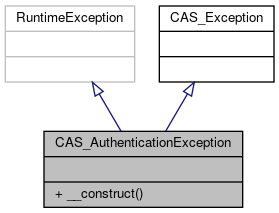This interface defines methods that allow proxy-authenticated service handlers to interact with phpCAS. More...
 Inheritance diagram for CAS_AuthenticationException:
Inheritance diagram for CAS_AuthenticationException: Collaboration diagram for CAS_AuthenticationException:
Collaboration diagram for CAS_AuthenticationException:Public Member Functions | |
| __construct ($client, $failure, $cas_url, $no_response, $bad_response='', $cas_response='', $err_code='', $err_msg='') | |
| This method is used to print the HTML output when the user was not authenticated. More... | |
Detailed Description
This interface defines methods that allow proxy-authenticated service handlers to interact with phpCAS.
Proxy service handlers must implement this interface as well as call phpCAS::initializeProxiedService($this) at some point in their implementation.
While not required, proxy-authenticated service handlers are encouraged to implement the CAS_ProxiedService_Testable interface to facilitate unit testing.
Definition at line 48 of file AuthenticationException.php.
Constructor & Destructor Documentation
◆ __construct()
| CAS_AuthenticationException::__construct | ( | $client, | |
| $failure, | |||
| $cas_url, | |||
| $no_response, | |||
$bad_response = '', |
|||
$cas_response = '', |
|||
$err_code = '', |
|||
$err_msg = '' |
|||
| ) |
This method is used to print the HTML output when the user was not authenticated.
- Parameters
-
CAS_Client $client phpcas client string $failure the failure that occured string $cas_url the URL the CAS server was asked for bool $no_response the response from the CAS server (other parameters are ignored if TRUE) bool $bad_response bad response from the CAS server ($err_code and $err_msg ignored if TRUE) string $cas_response the response of the CAS server int $err_code the error code given by the CAS server string $err_msg the error message given by the CAS server
Definition at line 68 of file AuthenticationException.php.
References $_SERVER, $client, $failure, $lang, $messages, CAS_VERSION_1_0, CAS_VERSION_2_0, CAS_VERSION_3_0, phpCAS\trace(), phpCAS\traceBegin(), and phpCAS\traceExit().
 Here is the call graph for this function:
Here is the call graph for this function:The documentation for this class was generated from the following file:
- Services/CAS/lib/CAS/AuthenticationException.php



